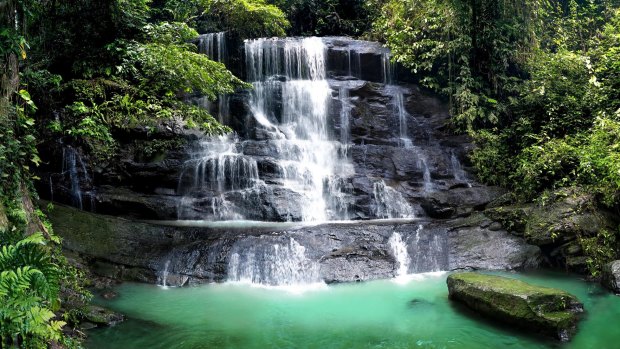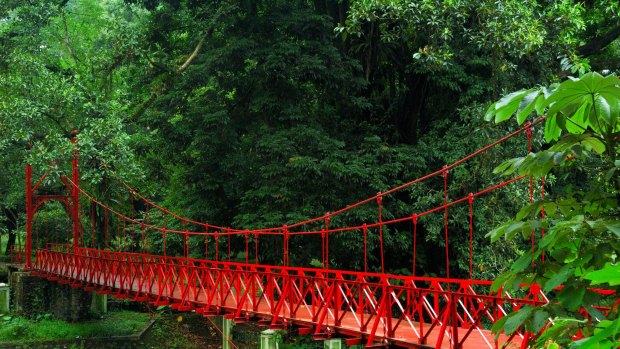By Steve Meacham

Is this really Jakarta? A waterfall in Bogor Botanic Gardens. Credit: Shutterstock
The sense of peace is sublime. Aside from birdsong, the croak of frogs from the lily ponds, and the whispered wing beats of bats flying in the harsh reality of the sun, only one sound can be heard this Indonesian morning: happy children.
Can all this greenery be in Jakarta?
Those who have never been here before (like myself) can quote myriad reasons not to come to the megalopolis. Isn't it dirty? Synonymous with excruciating traffic? A hellhole to be endured rather that enjoyed?

A hanging bridge in the Bogor Botanic Gardens.Credit: Fadil Aziz / Alamy Stock Photo
Well, yes and no.
This morning I'm in Bogor, once a hill station frequented by Dutch colonial governors so desperate to escape the heat, noise and hubbub of Jakarta (or Batavia as it was during the days of the Dutch East Indies Company) that they created a second governor's palace among the swift-flowing rivers and cooler temperatures 60 kilometres south. Bogor, nicknamed "Rain City", was then a separate town. Even today, locals speak a different dialect.
Now it's the southern terminus of Jakarta's cheap, clean, efficient commuter railway system. The 90-minute ride from central Jakarta costs $3.60 return and comes with English language instructions as you buy your ticket and at each station.
My guide, Iwan, was waiting as arranged at Bogor railway station at 10am. At each change of line, railway staff had identified me as a stranger and pointed me in the right direction. So, too, did fellow passengers aboard the trains, from schoolchildren to pensioners: all happy to practice their English and help a confused visitor. Bogor Palace, now the centre of Kebun Raya Bogor (Bogor Botanic Gardens), is one of six Presidential residences in Indonesia. It dates back to 1744 when Gustaf Willem Baron von Imhoff, Governor General of the Dutch East Indies, selected this spot in the hills.
In 1942, the presidential palace, destroyed and rebuilt after the volcanic explosion of Mount Selak in 1834, was occupied by the Imperial Japanese as they threatened further assaults on Australia after the bombing of Darwin.
Today it is seen as a crucible of Indonesian independence, having hosted every Indonesian head of state from Sukarno to Widodo. Here in 1966, "the Order of March 11" was typed and signed, transferring power from the founding father Sukarno to his successor, Soeharto, who would rule Indonesia with an iron fist for the next 32 years.
Entering the presidential palace is not easy. There are few guided tours, and you'll need to book well in advance.
But most Indonesian and foreign visitors are content to gaze at the palace across the lakes from the many surrounding gardens.
Bogor Botanic Gardens is the largest and oldest in south-east Asia. Covering 87 hectares, it contains almost 14,000 different trees and plants and has been a major research centre for the development of commercial crops such as tea and palm oil (which has led to the decimation of so much of south-east Asia's native jungle). You could easily spend an entire day here, and the twin orchid houses are a favourite attraction. Or, head out of town to one of the many waterfalls where you can swim in the bracing water.
However, I was particularly honoured because Iwan took me through the back alleys and raging rivers to meet his family. They live, all seven of them, in a tiny house full of children (most of them belonging to neighbours).
As a tour guide of 25 years standing, Iwan usually leaves home at about 6am and is rarely home before 9pm.
If this seems a hard life, Iwan takes me to one of the last remaining foundries in Bogor making ceremonial gongs.
The men, stripped to the waist, work in Dickensian conditions in a darkened, smouldering room dominated by an open furnace.
It's just 10 minutes from the botanic gardens, but it could be another country, another century.
TRIP NOTES
MORE
FLY
Qantas and Garuda Indonesia fly direct from Australia to Jakarta.
VISIT
Bogor Botanic Gardens is a 10-minute taxi from Bogor station. See bgci.org
Steve Meacham travelled at his own expense.
Sign up for the Traveller Deals newsletter
Get exclusive travel deals delivered straight to your inbox. Sign up now.